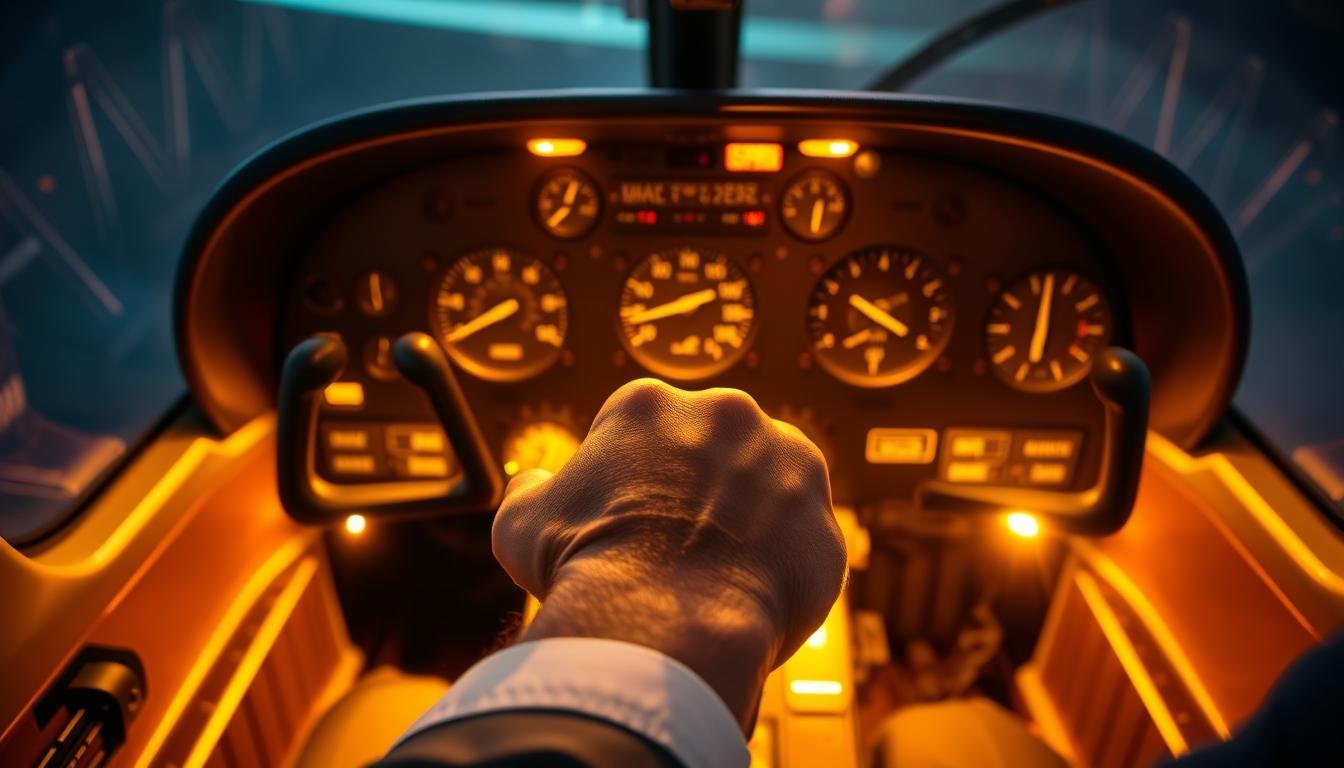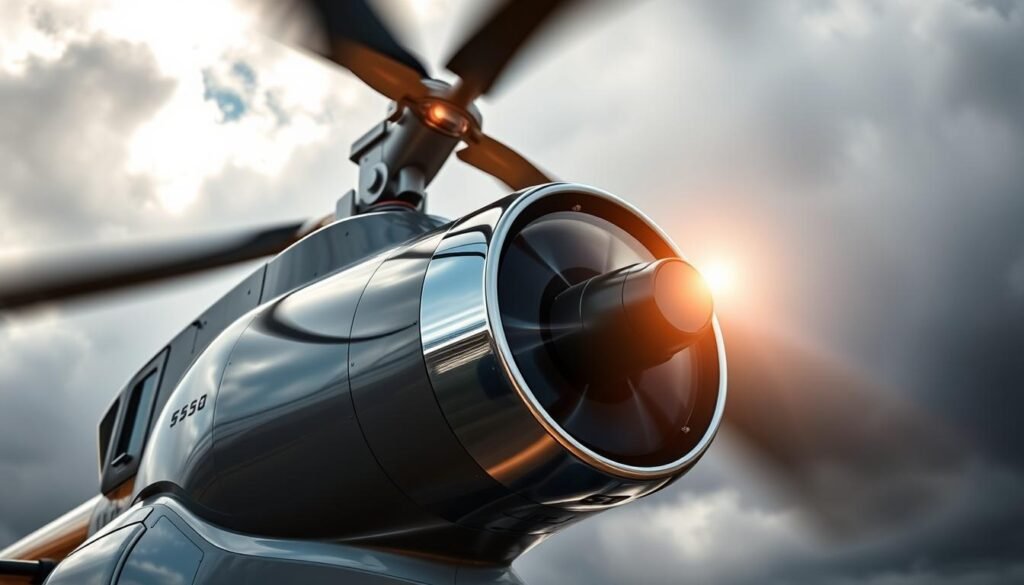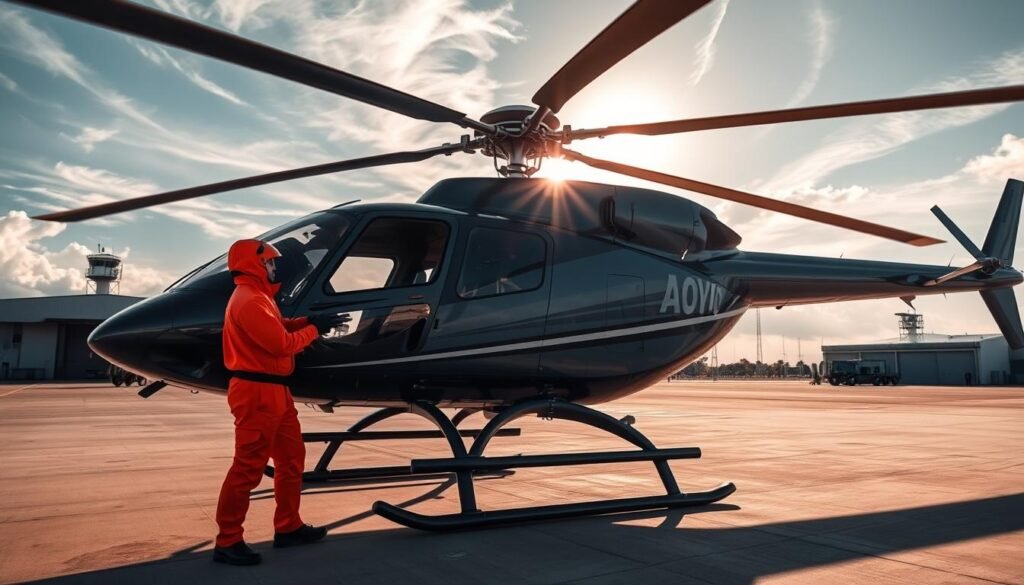One study found that disciplined preflight checks cut preventable in-flight events by over 40%, a figure that shows the real cost of skipped steps in aviation. The preflight routine is not optional; it is the first line of defense for pilots, passengers, and the operator.
The guide frames a repeatable, standardized flow that uses a pause-and-point technique so crews never rely on memory. Exterior inspection covers fuselage, tail boom, rotor blades, landing gear and antennae.
Crew members must sump fuel, confirm oil and hydraulic levels, and test electrical pre-start items such as battery voltage and circuit breakers. Cockpit checks include altimeter set, comms and nav verification, transponder setup, and warning light cycles.
Model nuances matter: specific checks for the R44, Bell 206, and Airbus H125 must be integrated into the routine. Proper documentation and adherence to FAA and EASA guidance reinforce the checklist’s role as a professional tool to reduce human error and avoid mission-ending consequences.
Key Takeaways
- A disciplined preflight process reduces avoidable incidents and improves reliability.
- Use a standardized flow with pause-and-point instead of relying on memory.
- Inspect airframe, rotors, fuel quality, powerplant, and electrical systems every time.
- Verify cockpit instruments, comms/nav, and warning light tests before start.
- Include cabin gear, documents, and model-specific items in the routine.
Helicopter Safety Checklist Overview And Search Intent
A clear preflight overview tells pilots what to check, why each step matters, and how to perform the work before engine start.
Mandated by FAA and EASA, the preflight inspection is a legal and operational requirement that ensures airworthiness and accountability for every flight.
The practice uses printed or digital checklists and a standardized flow with a pause-and-point confirmation to reduce missed items. Pilots should complete the sequence before engine start on every sortie.
Mindset and situational awareness are central. A disciplined approach reduces human error and lowers operational risk across varied operating contexts.
- Scope: exterior airframe, fuel and engine, cockpit systems, and cabin safety items.
- Execution: use physical or app-based lists, not memory; allow time and avoid shortcuts.
- Compliance: stay current with regulations and HAI/agency guidance to maintain pilot competence.
Outcome: a repeatable sequence that improves consistency, legal compliance, and overall aviation performance. The following sections unpack the exact steps and technical checks.
Preflight Timing, Process Discipline, And Compliance
Setting aside a fixed window for preflight work ensures no step is skipped under schedule pressure. The crew must complete all inspections before engine start every single time.
Process Discipline: Standardized Flow And Pause‑And‑Point
A standardized flow sequences checks logically around the aircraft to reduce backtracking. The pause‑and‑point method requires the pilot to point at each item, name it aloud, and confirm it visually or by touch.
- Plan start time to allow full checks without rushing.
- Follow a consistent left‑to‑right or nose‑to‑tail flow per airframe.
- Use printed or electronic lists to avoid memory reliance.
Risk And Mindset: Time Pressure, Complacency, And Situational Awareness
Rushing under time pressure and complacency are leading precursors to errors. Pilots must watch for unusual smells, noises, or vibrations and log any discrepancies immediately.

| Action | Purpose | Compliance Note |
|---|---|---|
| Schedule adequate preflight time | Reduces hurried checks and missed items | Supports FAA and EASA procedural requirements |
| Use pause‑and‑point | Improves verification reliability | Simple, repeatable method for all pilots |
| Document and defer dispatch if needed | Prevents flights with unresolved critical faults | Maintains legal and operational accountability |
Final note: Consistent process discipline helps detect latent faults in systems, lowers risk, and keeps pilots accountable regardless of prior maintenance or recent flights.
Exterior And Airframe Checks Before Engine Start
Begin the exterior walkaround with a consistent route, then work nose to tail to avoid missed items. They should treat this as a visual and tactile inspection, noting anything that looks out of place.

Fuselage And Tail Boom: Corrosion, Dents, Cracks, And Leaks
Inspect the fuselage and tail boom for corrosion, dents, and surface cracks. Look for streaking or residue that signals fluid leaks under panels or at fittings.
Main Rotor Blades And Head: Nicks, Cracks, Delamination, Attachments
Run a gloved finger along blade leading edges to feel nicks or delamination. Verify each attachment and the rotor head hardware for secure safetying and abnormal play.
Tail Rotor And Driveshaft Area: Security, Connectors, And Clearances
Check tail rotor links, bearings, and driveshaft connectors for corrosion and security. Pay special attention to known model problem areas such as Bell 206 driveshaft connectors.
Landing Gear, Lights, Antennae, And General Condition
Examine skids or wheels for damage, fastener security, and wear. Confirm landing and position lights and antennae are mounted and functional.
When To Escalate: Cosmetic dents that do not affect structure may be logged, but cracks, leaks, or loose hardware require immediate maintenance and grounding until cleared.
| Area | What To Look For | Action |
|---|---|---|
| Fuselage/Tail Boom | Corrosion, dents, streaks, cracks | Document and tag for maintenance if structural concerns |
| Main Rotor/Head | Nicks, delam, loose attachments, abnormal play | Secure fasteners; do not dispatch if safetying is compromised |
| Tail Rotor/Driveshaft | Connector corrosion, bearing security, clearances | Escalate Bell 206 connector issues to maintenance |
| Gear/Lights/Antennae | Wear, missing fasteners, inoperative lights | Repair or replace before flight; log defects |
Documentation: Record any discrepancies and prohibit dispatch until maintenance verifies corrective action. For a compact reminder of critical items, review preflight items you should never skip.
Fuel, Engine, And Critical Systems Inspection
A quick, methodical fuel and systems review can stop a minor issue from becoming an in-flight emergency.
Fuel Quantity And Quality: Sample fuel from each sump with a tester. Confirm the sample is clear and free of water or debris. Reconcile tank quantity against planned flight plus reserves before dispatch.
Fuel Quantity And Quality: Sumps, Water, And Debris
Draw fuel from every drain point and check for separation or particulates. If contamination appears, tag the aircraft and contact maintenance immediately.
Oil, Hydraulic, And Fluid Levels: Leaks, Hoses, And Pressure
Verify oil and hydraulic levels per the aircraft manual. Inspect caps, dipsticks, and sight glasses. Scan hoses and fittings for leaks or chafing and log any anomalies.
Powerplant And Gearboxes: Compartments And Wear Indicators
Open engine and transmission panels to inspect for cleanliness and wear. Check gearbox oil where applicable, noting models like the Bell 206 with separate gearbox service.
Electrical And Startup Prereqs: Battery, Circuit Breakers, Master, Fuel Pump
Confirm battery voltage is within limits and all circuit breakers are set. Operate the master and verify fuel pump function before start. Cross-check gauges during initial power application to validate indications.
| Item | What To Inspect | Action |
|---|---|---|
| Fuel | Clear, water-free, quantity vs reserves | Sample each sump; defer flight if contaminated |
| Fluids | Oil, hydraulic levels, hose condition | Top or tag for maintenance if outside limits |
| Gearbox & Powerplant | Leaks, oil level, wear indicators | Open panels; verify service intervals and report faults |
| Electrical | Battery voltage, breakers, pump operation | Verify before start; log and fix any irregularities |
Final steps: Scan rotor drive couplings visible from access panels, reseat caps, secure panels, and remove tools or rags. Log discrepancies and coordinate with maintenance; do not dispatch with unresolved faults.
Cockpit, Avionics, And Instruments Readiness
Before power is applied, the cockpit must be methodically configured so every instrument reads correctly and every crew control is functional. This stage prevents surprises and confirms systems will behave as expected during taxi and takeoff.

Altimeter, Gauges, And Warning Lights: Set, Test, Verify
Set the altimeter to field elevation and perform annunciator and warning light test cycles. Confirm lights illuminate during the test and then extinguish as designed.
Power up and cross‑check engine and system gauges for normal indications on initial power application. Any abnormal reading requires immediate investigation and may ground the flight.
Comms, Nav, GPS, Transponder: Configuration And Function Checks
Program radios, preset frequencies, load the planned route into GPS, and set the transponder code. Perform function checks for clarity, signal integrity, and correct position reporting.
Set the audio panel and intercom for clear crew communications. Verify portable device power and backups so navigation and weather sources remain redundant.
Cabin Safety And Documents: Seatbelts, Doors, ELT, Fire Extinguisher, First Aid, Records
Inspect seatbelts and harnesses for wear and positive latching. Verify doors and latches close and lock to prevent in‑flight opening.
Confirm ELT status, the presence and condition of a fire extinguisher and a first aid kit appropriate for the mission. Stow loose equipment to prevent projectiles or control interference.
Validate required records and credentials: pilot license, aircraft registration and airworthiness documents, radio operator’s license, and current charts. Use a cockpit checklist to ensure no item is missed under workload.
“A consistent cockpit flow reduces error and makes abnormal indications easier to spot.”
For reference on instrument profiles and IFR flows consult this resource: Twin IFR Profiles.
Model‑Specific Additions And Pilot Resources
Tailoring the preflight to the aircraft type ensures critical subsystems receive focused attention before power is applied.

Airframe Nuances: Robinson R44, Bell 206, Airbus H125 (AS350)
Robinson R44: add rotor blade damping checks and alternator belt tension to the flow.
Bell 206: verify separate gearbox oil level and inspect the tail rotor driveshaft connector for corrosion.
Airbus H125 (AS350): confirm VEMD initialization and validate the hydraulic backup system before dispatch.
Tools And Apps: Printable PDFs, ForeFlight, Garmin Pilot, HeliTrak
Use printable PDFs on a kneeboard and electronic workflows in ForeFlight, Garmin Pilot, or HeliTrak to record outcomes. These tools help track recurring defects and improve data quality when working with maintenance.
Regulatory Currency: FAA Advisory Circulars, EASA Bulletins, Operator Policies
Make sure operator policy libraries, MEL/CDL items, and recent advisory circulars are integrated into procedures. Routine review of regulations and bulletins keeps the crew current and aligned with fleet changes.
Recommendation: Conduct periodic peer reviews or safety meetings to benchmark best practices and standardize use of resources across pilots and helicopters.
Common Preflight Errors And How Experienced Pilots Avoid Them
Routine shortcuts and assumptions are the most common causes of preflight failures among active crews. Rushing under time pressure or skipping a walkaround in poor weather often leads to missed items. Experienced pilots treat each check as a critical step, not optional paperwork.
They make sure exterior and interior items are visually confirmed. When weather degrades, crews use shelters, headlamps, or a flashlight to inspect components. Starting earlier on busy days removes schedule pressure and reduces the temptation to shortcut.
Pilots must treat odd smells, noises, or vibrations as immediate grounds for further inspection. These cues can be precursors to systems faults or an impending emergency and should stop a dispatch until resolved.
Reviewing weather, NOTAMs, and local airspace changes before engine start lowers operational risk. Brief, scenario‑based emergency planning helps crews pick alternates and abort points quickly if conditions change during flights.

| Common Pitfall | Typical Cause | Experienced Pilot Action | Outcome |
|---|---|---|---|
| Rushing | Time pressure | Start earlier; enforce a fixed preflight window | Fewer missed items; reduced risk |
| Skipping checks in poor weather | Visibility, cold, wind | Use shelter or light aid; confirm visually | Better detection of damage or leaks |
| Assuming maintenance covered it | Overreliance on others | Independent verification of discrepancies | Prevents cascading consequences |
| Ignoring unusual cues | Normalization of deviance | Treat cues as hard stops; involve maintenance | Reduces likelihood of in‑flight emergency |
“Personal accountability and structured flows are the pilot’s best defense against preventable faults.”
Action items: use a structured preflight list, log lessons learned, coordinate recurring defects with maintenance, and schedule peer debriefs to keep standards high. For more on ride and flight risk perceptions, review this brief safety overview.
Conclusion
Thorough preflight preparation makes every flight more predictable and resilient to surprises. A complete helicopter preflight inspection is a frontline barrier and must be finished before engine start every time.
Verify exterior airframe and rotor integrity, confirm fuel quality and quantity, and check fluid levels, gearboxes, and electrical prerequisites. Cockpit readiness requires altimeter setting, instruments verified, and avionics configured.
Confirm cabin items: ELT, fire extinguisher, first aid, secured belts and doors, and required records. Use a standardized pause-and-point flow, allocate time, and manage pressure so the pilot’s mind stays focused.
Leverage model-specific steps and digital tools like ForeFlight or Garmin Pilot, follow regulations, document discrepancies, and coordinate with maintenance before dispatch. Methodical preparation raises reliability, professionalism, and overall flight safety.
FAQ
What is the most critical preflight inspection step for a pilot?
The pilot must establish a standardized flow to reduce omission risk. They should follow a written preflight procedure, physically verify rotor blades, tail boom, landing gear, and fuel before starting the engine. Consistent pauses at key points — often called pause‑and‑point — ensure sensors, gauges, and external condition checks are complete.
How long should a thorough preflight take?
A comprehensive walkaround and cockpit setup typically requires 15–30 minutes, depending on aircraft model and mission complexity. Rushing increases risk, so pilots should allow extra time for fuel sampling, fluid checks, and resolving any abnormal indications.
What should pilots look for on rotor blades and hub areas?
Inspect for nicks, cracks, delamination, corrosion, loose fasteners, and proper blade tracking. Check blade root attachments, pitch links, and the head for play or fluid leaks. Any suspect damage must be evaluated by maintenance before flight.
How is fuel quality verified during preflight?
Pilots drain fuel sumps and visually check for water, sediment, and proper color. They confirm total usable quantity matches planning needs and review fueling records. If contamination or incorrect grade is suspected, they must not fly until the source is cleared and fuel tested.
What cockpit items require attention before startup?
Set and test avionics, altimeter, attitude indicator, and engine monitoring gauges. Verify circuit breakers, battery charge, fuel pump operation, master switch behavior, and that transponder and radios function. Secure loose items and confirm emergency equipment is on board and accessible.
How do pilots manage time pressure and complacency?
They use checklists, time buffers, and sterile cockpit principles. Pilots prioritize critical tasks, delegate nonessential duties, and resist pressure to skip steps. Training that reinforces procedural discipline and CRM reduces complacency under operational stress.
Are model‑specific checks necessary? For example, Robinson R44 or Bell 206.
Yes. Each model has unique limits, inspection points, and service bulletins. Pilots must follow the manufacturer’s checklist for Robinson R44, Bell 206, Airbus H125 (AS350), or others, and incorporate mandatory ADs and operator additions into the preflight routine.
What common preflight errors lead to in‑flight problems?
Skipped fuel sump checks, missed loose fasteners, improper blade tracking, unsecured cabin items, and failing to verify control freedom are frequent causes. Experienced crews mitigate these by cross‑checking, adhering to checklists, and conducting thorough visual inspections.
When should maintenance be notified before a flight?
Immediately when structural damage, fluid leaks, abnormal vibration sources, failed instruments, or unresolved warning lights are found. Also report any hard landings, unusual noises, or discrepancies between gauges and expected values so technicians can inspect and log corrective action.
What emergency equipment is essential to verify during preflight?
Confirm ELT status, first aid kit completeness, fire extinguisher charge, life rafts or flotation gear where required, and personal survival equipment for overwater or remote flights. Ensure documentation and placards match onboard equipment and operational needs.
How should pilots document the preflight inspection?
Record the inspection in aircraft logs, flight release paperwork, or electronic apps like ForeFlight and Garmin Pilot when used for dispatch. Note any discrepancies, corrective actions, fuel uplift, and signatures per operator policy and regulatory requirements.
Which regulations guide preflight procedures and pilot currency?
FAA Advisory Circulars and FARs in the United States, EASA guidance in Europe, and operator manuals establish mandatory checks and currency standards. Pilots should stay current on bulletins, airworthiness directives, and company SOPs that affect preflight duties.ty, ensuring that the aircraft is in proper working order before takeoff. By thoroughly checking the helicopter’s exterior, rotor system, hydraulic and fuel systems, flight controls, and engine, pilots can minimize the risk of in-flight emergencies and ensure a safe flight. Regular and thorough pre-flight inspections are not only a legal requirement but also a critical step in maintaining the safety and reliability of the aircraft.
Related Articles
- How to Avoid Common Helicopter Pilot Errors: A Guide to Safe Flying
- The Role of Air Traffic Control in Helicopter Safety
- Helicopter Safety in Bad Weather: Tips for Flying in Adverse Conditions
- How to Safely Land a Helicopter in Challenging Conditions
- The Importance of Proper Helicopter Maintenance for Flight Safety
More from This Category
- Understanding Helicopter Weight and Balance: Why It’s Crucial for Safe Flying
- Emergency Procedures in Helicopter Flights: How to Handle In-Flight Incidents
- Helicopter Pre-Flight Inspections: What Pilots Must Check Before Takeoff
- How to Prepare for Your First Helicopter Ride: Safety Procedures for Passengers
- Top 10 Helicopter Safety Tips Every Pilot Should Know



